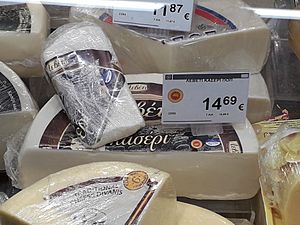Kasseri facts for kids
Kasseri (pronounced Kah-SEH-ree) is a yummy, pale yellow cheese. It's usually medium-hard or hard. This cheese is mostly made from sheep milk, and sometimes a little bit of goat's milk is added too. You can find similar cheeses in Turkey, Romania, and the Balkans, where they are often called kashkaval.
Contents
What is Kasseri?
Kasseri cheese is special because it has a "protected designation of origin" (PDO). This means that for a cheese to be called "Kasseri" in Greece, it must be made in specific areas like Thessaly, Macedonia, Lesbos, or Xanthi. If a similar cheese is made with cow's milk, it cannot be sold as "Kasseri" in the EU.
Kasseri is a smooth cheese that isn't crumbly. It's a bit chewy and has a firm outer skin. It belongs to a group of cheeses called pasta filata. This Italian name means "spun paste" and describes how these cheeses are made. Other cheeses in this family include fresh ones like mozzarella and aged ones like Provolone.
How is Kasseri Made?
Making Kasseri is a careful process:
- First, milk is warmed to about 36 degrees Celsius (97°F).
- Then, something called rennet is added. This helps the milk turn into a soft, jelly-like substance called curd in about 45 minutes.
- The curd is cut into small pieces, like corn kernels.
- These pieces are cooked at 38-40 degrees Celsius (100-104°F) while being stirred.
- Next, the curd is moved to tables where it's broken into even smaller pieces by hand.
- It's then wrapped tightly in cheesecloth, pressed with a small weight, and left to drain. This step also lets it ferment until it reaches a certain acidity (pH 5.2).
- After draining, the curd is cut into thin slices.
- These slices are put into hot water (70-80 degrees Celsius or 158-176°F).
- The cheese is then kneaded until it becomes a soft, stretchy mass. It should be so stretchy that you can pull it into a smooth thread at least 1 meter (about 3 feet) long!
- Salt is added to the kneaded cheese.
- Finally, the cheese is put into molds for two or three days.
- After molding, it's aged for at least three months at 18 degrees Celsius (64°F). This aging process gives Kasseri its special flavor.
Where Does the Name Come From?
The name Kasseri comes from the Turkish word kaşer. This word, in turn, comes from the Hebrew word kosher, which means "fit" or "proper" according to Jewish law. It's believed that Jewish people in a place called Kırkkilise (now Kırklareli, Turkey) invented this cheese. They made it without using certain ingredients, which made it suitable for their dietary rules.
How is Kasseri Eaten?
Kasseri is a popular cheese that can be enjoyed in many ways:
- It's often used in sandwiches.
- It's the main ingredient in a Greek pastry called kasseropita.
- It's also famous in a dish called saganaki, where slices of cheese are fried until golden and crispy.
- Assyrians use Kasseri cheese to make a traditional dish called "Gupta Tomirta," which means "buried cheese." This dish is usually topped with cumin and other spices.
See also
 In Spanish: Kasseri para niños
In Spanish: Kasseri para niños


